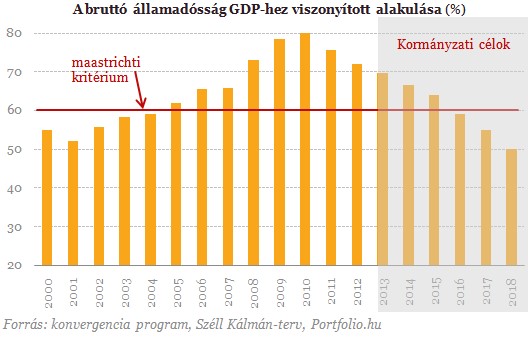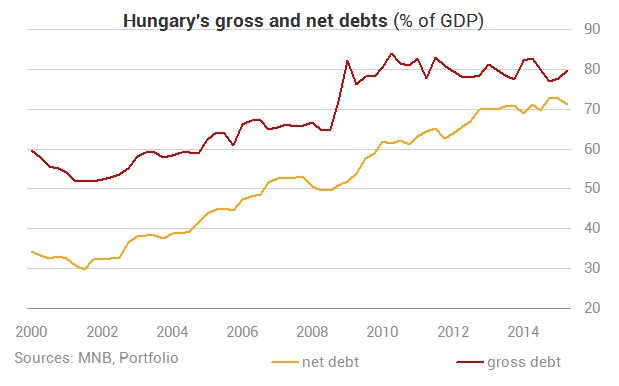The Hungarian government’s financial policies have failed miserably.
After coming to power in 2010 Mr. Viktor Orbán’s primary policy objective was to reduce the public debt. His government emphasized the importance of the “debt freedom-fight” and the struggle to liberate Hungary from Western financial domination to “regain the country’s national sovereignty.”
Orbán’s government inherited an almost catastrophic debt situation. Public debt stood at 82.2% of GDP at the end of the first quarter of 2010 and the country was hanging on an IMF loan lifeline. The Gyurcsány and Bajnai governments had mismanaged finances and ministers Mr. Veres and 36 year-old Mr. Oszkó were incompetent. András Simon, the Central Bank’s Governor, was also a disaster.
Prime Minister Ferenc Gyurcsány resigned. To his credit, he realized that his team was partially responsible for this disaster. He should have called for a snap election, instead he passed the baton to fellow socialist Mr. Bajnai, who extended the agony.
Orbán announced the war on public debt in the 2011 State of the State Address. “We must and will defeat government debt, which is the source of most of our problems and difficulties today. If we do not overcome it, then it will overcome us once and for all.”
Economy Minister György Matolcsy presented actual numbers. The government would reduce public debt to 65-70 percent of GDP by 2014. The government’s Kálmán Széll plan had detailed charts of the declining debt. It would be under 60% of GDP by 2016 and under 50% by 2018 – the plan promised. (Read here.)
Finally some sensible financial leadership – I thought. How little I knew!
Today Hungary’s debt rating is still in junk by Moody’s and Standard & Poor’s and it is hovering around 80% of GDP, presently at 77%. Not much improvement since 2010. Having it under 50% by 2018 is impossible. Significant debt reduction won’t happen anytime soon, probably not in our lifetime. (Read Hungarian language article about the current debt situation here.)
Mr. Orbán’s plan failed. His team: Mr. Varga and Mr. Matolcsy were unable to deliver the goods, in fact, during their tenure the situation got worse. Hungary’s gross debt has not increased, but net debt did. In other words, the country got significantly poorer with less and less “crown jewels” to sell, Hungary is in a hopeless debt trap.
To be fair, his government had a couple of good moves. Economy minister Mr. Varga was named Finance Minister of the Year, Central and Eastern Europe 2015, by London-based Euromoney Emerging Markets magazine. The main reason Mr. Varga received this award was his perfect timing of the conversion of Hungary’s foreign currency mortgages. The conversion happened before the Swiss Central Bank decided to let the franc rise substantially. Yes, his timing was brilliant – and pure luck!
Central Bank boss György Matolcsy has introduced an interest rate reduction policy. He executed it in loose credit environments, the money taps were wide open. Quite a bit of luck there too.
One promising sign is that Fitch Ratings recently became the first ratings agency to raise the country’s sovereign debt rating from “junk” to “investment grade” since Hungary was downgraded five years ago.
But the bottom line is that Mr. Orbán’s team has failed in their most important task: reducing the country’s sovereign public debt.
The government’s spin-doctors are trying to hide the bad news from the public. Mr. Orbán is suggesting further budget reductions and he knows well that education, health care and transportation will suffer. The government can expect strikes and growing instability in Hungarian society. Nationalist propaganda and soccer stadiums probably won’t do the trick this time; the government has started to spend more to beef up the riot police
Make no mistake, the last six years under Mr. Orbán was hard, and I have a feeling that the next decade, independently from Hungary’s leadership, will be even harder; at least, for those who decide to stay in Hungary. More and more young people leave and choose to move to other EU countries or overseas.
Prime Minister Orbán’s plan is to hide the debt reduction failure with government propaganda and he is not prepared to admit that Hungary’s debt situation has not improved. Statistically, Hungary already is one of the poorest countries in Europe, recently became the poorest of the Visegrad Four – Poland, Slovakia, Czech Republic and Hungary. No sign that this will change anytime soon.
György Lázár






